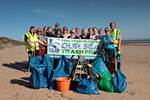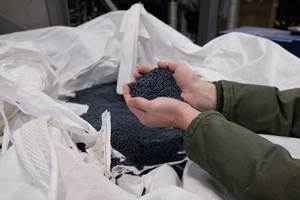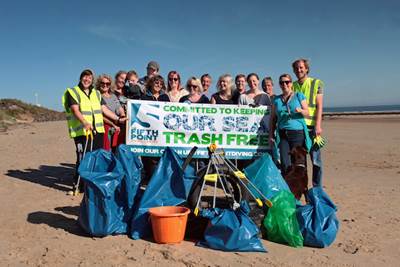Beach Plastic: A Recycling Story
Plastics Technology went to the beach in San Diego; not for surfing but to see first hand how local collection of beach plastic is enabling P&G's newest sustainable package.
The plastic waste accumulated in oceans is like something out of a horror movie. According to the Ellen MacArthur Foundation (EMF), 95% of the value of plastic packaging material, worth $80-120 billion annually, is lost to the economy and on the current track, there could be more plastics than fish in the ocean (by weight) by 2050.
With such a huge problem to address, it calls for some creativity and innovation, which is how ‘beach plastic’ came to be. Earlier this year, P&G gained worldwide headlines when it announced that its Head & Shoulders brand will produce the world’s first recyclable shampoo bottle made from up to 25% recycled beach plastic.
I first covered the announcement back in January and since then have interviewed reps from P&G and their recycling partner, TerraCycle. In addition, in February, my colleague Tony Deligio and I traveled to San Diego to interview a beach cleanup organization, a key component in this whole initiative. And that’s where the beach plastic story begins.
Chapter 1: Clean-up
The first major step in establishing a unique supply chain involves the support of thousands of volunteers and hundreds of NGOs collecting plastic waste found on beaches. Once of these organizations is I Love A Clean San Diego, whose members work to ensure the entire city of San Diego is waste-free, including the beaches. Pia Piscitelli, marketing manager of I Love A Clean San Diego, said that the organization’s recycling and hazardous waste hotline and database directed over 13,000 recycling inquiries last year from residents in San Diego County. And in 2016, the group had 33,000 volunteers at over 250 cleanup sites throughout San Diego County. They picked up over 433,000 pounds of litter and debris at the cleanups.
Check out the video below where Pia explains how I Love a Clean San Diego is working with the TerraCycle beach plastic initiative:
Chapter 2: The Recycling Process
Brett Stevens, vice president of material sales and procurement at TerraCycle, says that it’s important to engage with organizations that are already conducting beach clean-ups (such as I Love A Clean San Diego).
“What TerraCycle does is layer onto the collection efforts that are already happening. The pitch is basically to say that ‘We know you’re collecting material off of beaches, but it still ends up in the garbage or a landfill. We want to take the rigid plastic portion of your collections and use those plastics to make new products,’” he says. “We are taking a large percentage of the waste collected on beaches and making new products.”
TerraCycle accepts all rigid beach plastics that are found along any shoreline. Participation is free and all shipments must be sent through a freight shipment that is coordinated with TerraCycle. The recovered material is then shipped to one of TerraCycle’s warehouses where the staff manually sorts non-compliant items that are considered contaminants, such as organic matter, flexible plastic bags and films, rope, and fishing nets. Once that work is complete, the rigid plastic waste is sent to another processing facility where it is separated by type, cleaned, and converted into a usable new format.
“If you put all of the waste that comes off the beaches into a mechanical sorting line at a large-scale recycling facility, you would damage or break the machines pretty quickly,” Stevens says. “There would be some obvious contamination in the stream, and the operation would quickly be shut down. That’s why it’s important to make sure the material we send in for the mechanical part of the process won’t pose any danger to our partner facilities.”
The Head & Shoulders project is launching in France so TerraCycle is working with Paris-based waste management company Suez for the different stages of processing. The collected and pre-sorted material is then mechanically sorted, and by the end of the process, there are separate piles of HDPE, PET and so on. These separate piles are further shredded down, washed and dried so that the resulting output is a clean regrind. Since the P&G bottles are made from HPDE, TerraCycle and Suez are focused on recovering HDPE. The other materials recovered, such as PET and PP, are reused into other consumer product packaging or recycled products.
The beach plastic HDPE regrind is blended with virgin HDPE and a number of additives to ensure the finished pellets meet the specifications of P&G’s bottle manufacturer. TerraCycle supplies the pellets to the bottle manufacturer, and then the bottle manufacturer uses a combination of its own material and TerraCycle-supplied material to mold the final product – a shampoo bottle made 25% from beach plastic.
“Between the packaging requirements and quality of finished product, right now we are comfortable with 25%. P&G’s goal is to gradually increase the amount of recycled content (including beach plastic) in its packaging, but right now the inclusion of beach plastic is capped at 25%,” Stevens says.
Chapter 3: The Finished Product
The limited-edition bottle is set to launch in France in summer 2017. Virginie Helias, vice president of global sustainability at P&G, told me that one of the reasons they launched such an ambitious plan was a way to increase the awareness of recycling.
“It helps to raise awareness to people who are buying the products,” she says. “On the bottle we explain very clearly what they can do; we tell them that the bottle itself is recyclable, and that they should recycle it in order to help reduce ocean waste. When people are able to do something very tangible and concrete, it helps establish habits of sustainability behavior.”
The announcement was also two-fold: one was the beach plastic bottle and the second is that about ½ billion bottles of P&G hair care products will be made with recycled plastic every year by 2018.
OK, so the elephant in the room is cost. Obviously, this process is more time-consuming and cost-intensive than just using virgin material, so does the cost pass on to the consumer? Helias says no.
“There’s no cost to pass on to consumer and the reason is we want to do something for the environment and it’s very important to appeal to the mainstream audience,” she says. “It’s the no. 1 shampoo bottle and it’s not a niche initiative. There is an increased cost in collection and a very manual process with extra cleaning and processing cost, but we are taking it on.”
As this initiative is launching in Europe, P&G wants to bring the beach plastic packaging to the North America as well but there needs to be more supply. “As supply comes available, we will be able to do it in regions such as North America, western Europe and Asia,” she says.
We’ll see where this initiative will go, but Stevens of TerraCycle believes in the end, beach plastic has a story to tell that other materials don’t.
“We call them ‘storied plastics,’” he says. “TerraCycle is engaging directly with its collectors, who are by nature consumers of these consumer packaged goods. We know where the material is coming from, we have full trackability of the supply chain, and we have isolated categories of waste. These are sellable commodities to our brand partners, retailers, and consumers,” Stevens continued. “There’s a whole marketing and PR story there, and we would like to see more brands use recycled content in their plastic with a story behind it. The difference between other post-consumer resins and ours is that we have a story to tell.”
Related Content
Breaking News From NPE2024
Here is a firsthand report of news in injection molding, extrusion, blow molding and recycling not previously covered.
Read MoreFoam-Core Multilayer Blow Molding: How It’s Done
Learn here how to take advantage of new lightweighting and recycle utilization opportunities in consumer packaging, thanks to a collaboration of leaders in microcellular foaming and multilayer head design.
Read MoreScaling Up Sustainable Solutions for Fiber Reinforced Composite Materials
Oak Ridge National Laboratory's Sustainable Manufacturing Technologies Group helps industrial partners tackle the sustainability challenges presented by fiber-reinforced composite materials.
Read MoreNew Facility Refreshes Post-Consumer PP by Washing Out Additives, Contaminants
PureCycle prepares to scale up its novel solvent recycling approach as new facility nears completion.
Read MoreRead Next
P&G Unveils New Shampoo Bottle from Recycled Beach Plastic
The new Plastics Economy includes shampoo bottles made out of beach plastic.
Read MorePeople 4.0 – How to Get Buy-In from Your Staff for Industry 4.0 Systems
Implementing a production monitoring system as the foundation of a ‘smart factory’ is about integrating people with new technology as much as it is about integrating machines and computers. Here are tips from a company that has gone through the process.
Read MoreLead the Conversation, Change the Conversation
Coverage of single-use plastics can be both misleading and demoralizing. Here are 10 tips for changing the perception of the plastics industry at your company and in your community.
Read More






























